MKT01760: Critique & Comparison of Tourism Discussion Papers
VerifiedAdded on 2023/06/09
|10
|1939
|54
Report
AI Summary
This report critically evaluates and compares two discussion papers related to sustainable tourism in Australia. The first paper focuses on tourism initiatives in tropical Australia, emphasizing the connection between tourism development and community well-being, while the second paper discusses the national heritage tourism summit and the importance of heritage sites in attracting visitors. The report critiques the structure and content of both papers using the policy planning cycle, analyzing opportunities, identifying aims, exploring options, and evaluating the impact of proposed strategies. It also reflects on the understanding gained from both articles, highlighting the roles of government and non-governmental efforts in achieving sustainable tourism. The report concludes that sustainable tourism is essential for retaining market capitalization globally and that a hybrid network involving both governmental and private initiatives is crucial for establishing sustainability in the Australian tourism market. Desklib provides access to similar reports and study resources for students.
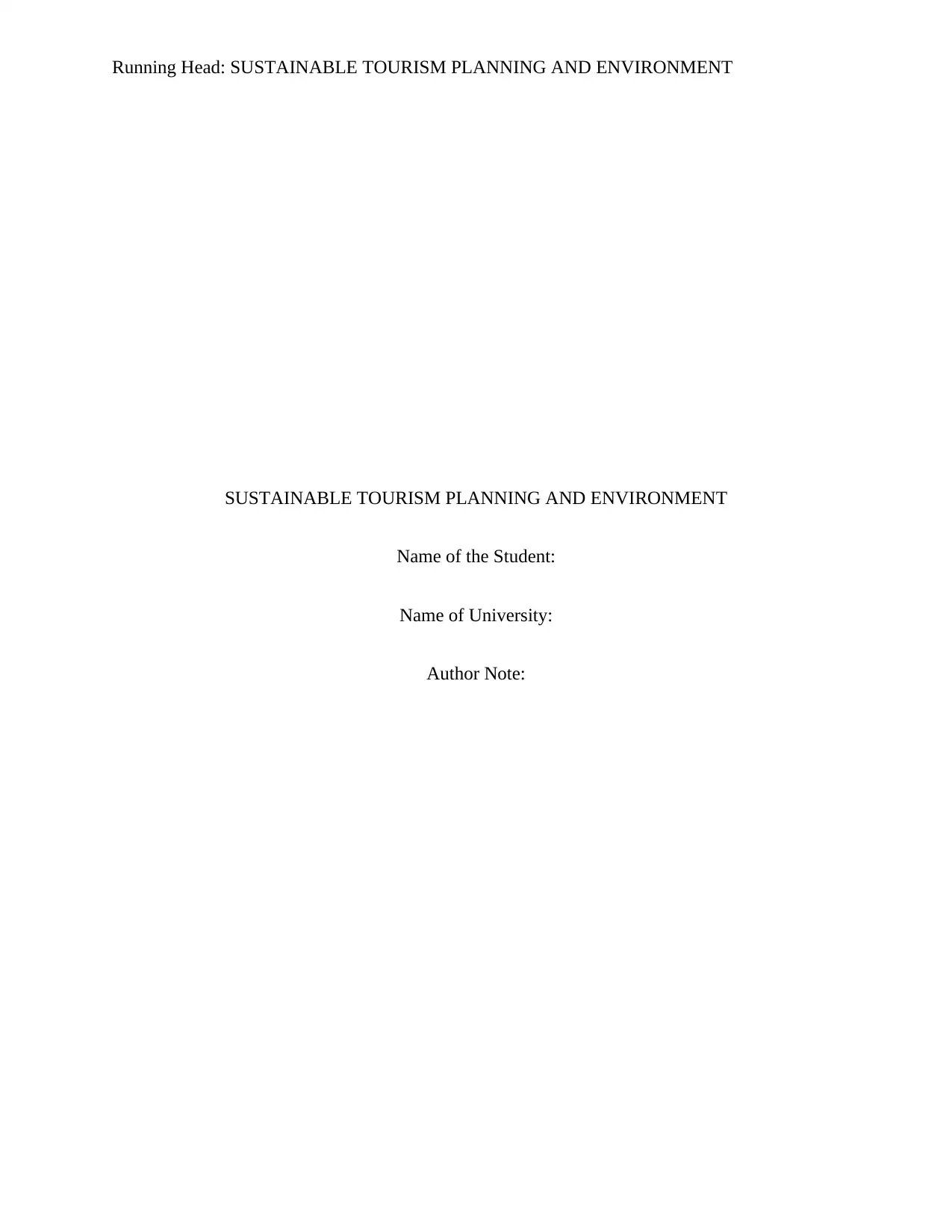
Running Head: SUSTAINABLE TOURISM PLANNING AND ENVIRONMENT
SUSTAINABLE TOURISM PLANNING AND ENVIRONMENT
Name of the Student:
Name of University:
Author Note:
SUSTAINABLE TOURISM PLANNING AND ENVIRONMENT
Name of the Student:
Name of University:
Author Note:
Paraphrase This Document
Need a fresh take? Get an instant paraphrase of this document with our AI Paraphraser
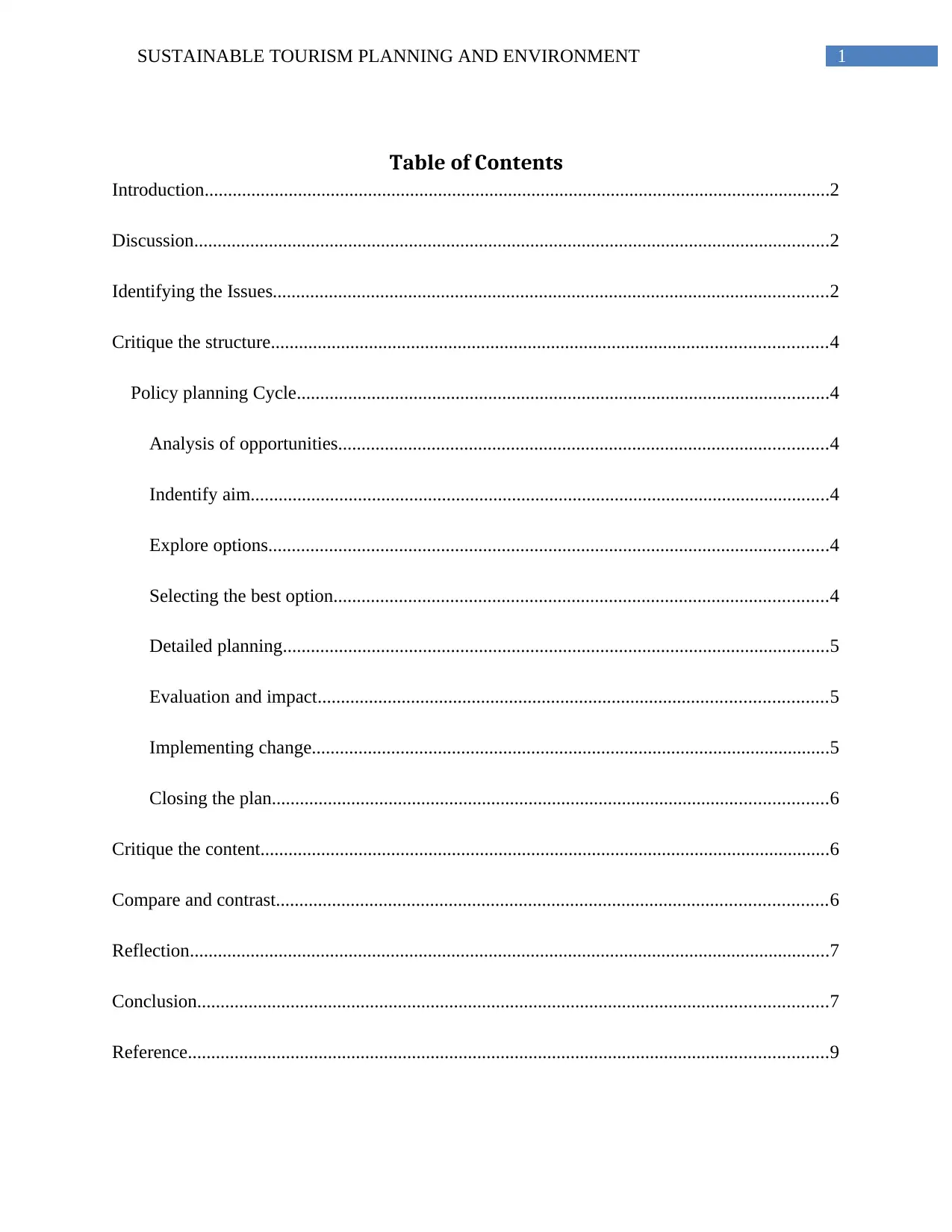
1SUSTAINABLE TOURISM PLANNING AND ENVIRONMENT
Table of Contents
Introduction......................................................................................................................................2
Discussion........................................................................................................................................2
Identifying the Issues.......................................................................................................................2
Critique the structure.......................................................................................................................4
Policy planning Cycle..................................................................................................................4
Analysis of opportunities.........................................................................................................4
Indentify aim............................................................................................................................4
Explore options........................................................................................................................4
Selecting the best option..........................................................................................................4
Detailed planning.....................................................................................................................5
Evaluation and impact.............................................................................................................5
Implementing change...............................................................................................................5
Closing the plan.......................................................................................................................6
Critique the content..........................................................................................................................6
Compare and contrast......................................................................................................................6
Reflection.........................................................................................................................................7
Conclusion.......................................................................................................................................7
Reference.........................................................................................................................................9
Table of Contents
Introduction......................................................................................................................................2
Discussion........................................................................................................................................2
Identifying the Issues.......................................................................................................................2
Critique the structure.......................................................................................................................4
Policy planning Cycle..................................................................................................................4
Analysis of opportunities.........................................................................................................4
Indentify aim............................................................................................................................4
Explore options........................................................................................................................4
Selecting the best option..........................................................................................................4
Detailed planning.....................................................................................................................5
Evaluation and impact.............................................................................................................5
Implementing change...............................................................................................................5
Closing the plan.......................................................................................................................6
Critique the content..........................................................................................................................6
Compare and contrast......................................................................................................................6
Reflection.........................................................................................................................................7
Conclusion.......................................................................................................................................7
Reference.........................................................................................................................................9
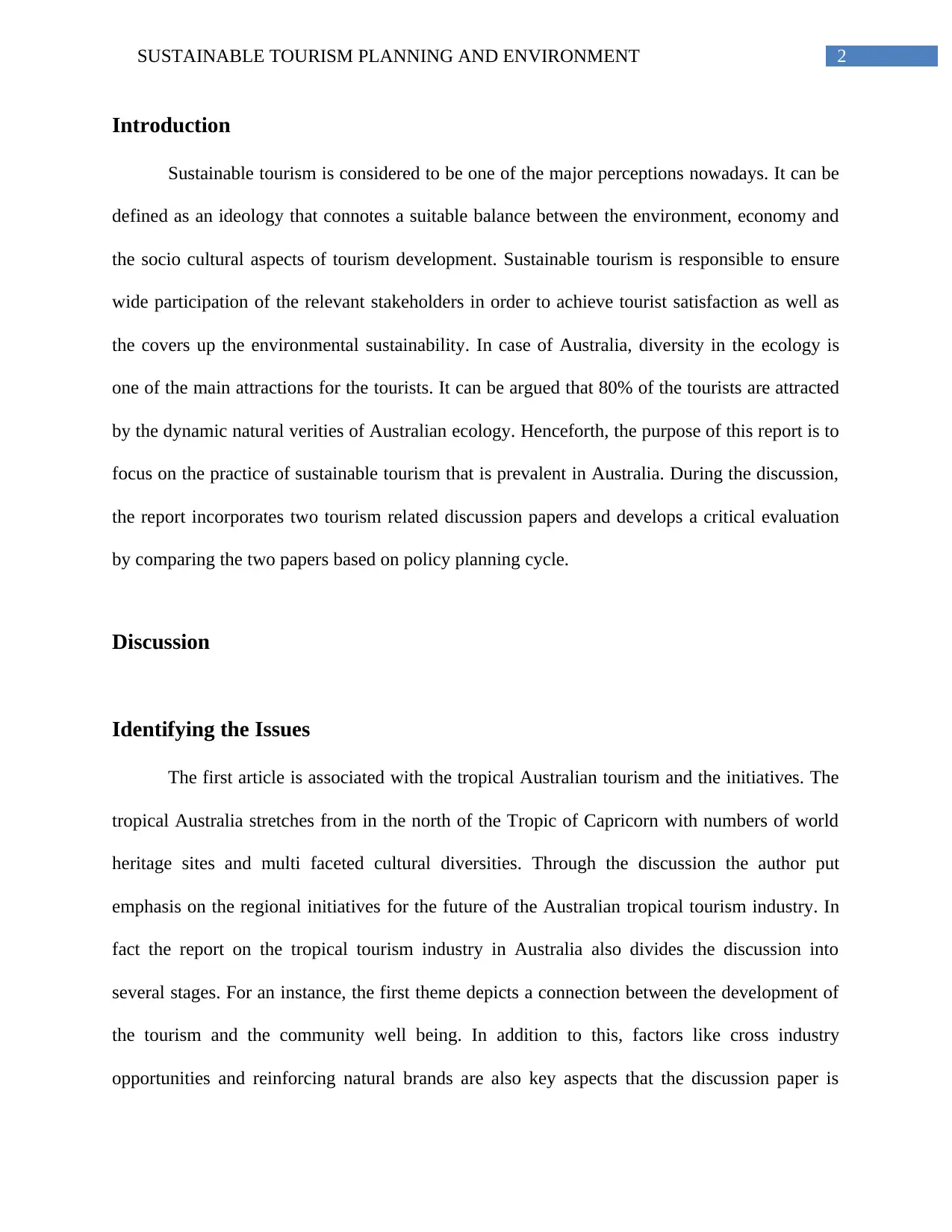
2SUSTAINABLE TOURISM PLANNING AND ENVIRONMENT
Introduction
Sustainable tourism is considered to be one of the major perceptions nowadays. It can be
defined as an ideology that connotes a suitable balance between the environment, economy and
the socio cultural aspects of tourism development. Sustainable tourism is responsible to ensure
wide participation of the relevant stakeholders in order to achieve tourist satisfaction as well as
the covers up the environmental sustainability. In case of Australia, diversity in the ecology is
one of the main attractions for the tourists. It can be argued that 80% of the tourists are attracted
by the dynamic natural verities of Australian ecology. Henceforth, the purpose of this report is to
focus on the practice of sustainable tourism that is prevalent in Australia. During the discussion,
the report incorporates two tourism related discussion papers and develops a critical evaluation
by comparing the two papers based on policy planning cycle.
Discussion
Identifying the Issues
The first article is associated with the tropical Australian tourism and the initiatives. The
tropical Australia stretches from in the north of the Tropic of Capricorn with numbers of world
heritage sites and multi faceted cultural diversities. Through the discussion the author put
emphasis on the regional initiatives for the future of the Australian tropical tourism industry. In
fact the report on the tropical tourism industry in Australia also divides the discussion into
several stages. For an instance, the first theme depicts a connection between the development of
the tourism and the community well being. In addition to this, factors like cross industry
opportunities and reinforcing natural brands are also key aspects that the discussion paper is
Introduction
Sustainable tourism is considered to be one of the major perceptions nowadays. It can be
defined as an ideology that connotes a suitable balance between the environment, economy and
the socio cultural aspects of tourism development. Sustainable tourism is responsible to ensure
wide participation of the relevant stakeholders in order to achieve tourist satisfaction as well as
the covers up the environmental sustainability. In case of Australia, diversity in the ecology is
one of the main attractions for the tourists. It can be argued that 80% of the tourists are attracted
by the dynamic natural verities of Australian ecology. Henceforth, the purpose of this report is to
focus on the practice of sustainable tourism that is prevalent in Australia. During the discussion,
the report incorporates two tourism related discussion papers and develops a critical evaluation
by comparing the two papers based on policy planning cycle.
Discussion
Identifying the Issues
The first article is associated with the tropical Australian tourism and the initiatives. The
tropical Australia stretches from in the north of the Tropic of Capricorn with numbers of world
heritage sites and multi faceted cultural diversities. Through the discussion the author put
emphasis on the regional initiatives for the future of the Australian tropical tourism industry. In
fact the report on the tropical tourism industry in Australia also divides the discussion into
several stages. For an instance, the first theme depicts a connection between the development of
the tourism and the community well being. In addition to this, factors like cross industry
opportunities and reinforcing natural brands are also key aspects that the discussion paper is
⊘ This is a preview!⊘
Do you want full access?
Subscribe today to unlock all pages.

Trusted by 1+ million students worldwide
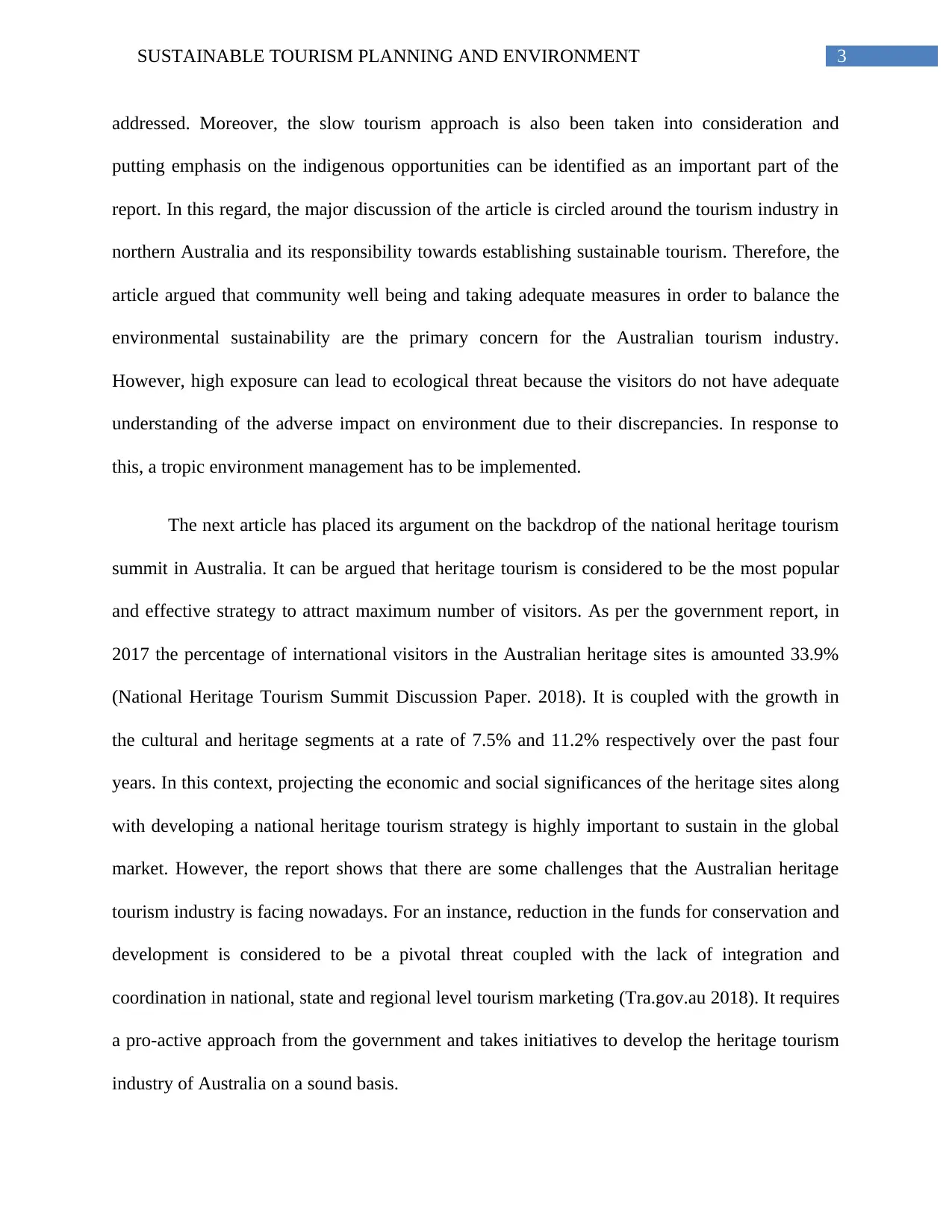
3SUSTAINABLE TOURISM PLANNING AND ENVIRONMENT
addressed. Moreover, the slow tourism approach is also been taken into consideration and
putting emphasis on the indigenous opportunities can be identified as an important part of the
report. In this regard, the major discussion of the article is circled around the tourism industry in
northern Australia and its responsibility towards establishing sustainable tourism. Therefore, the
article argued that community well being and taking adequate measures in order to balance the
environmental sustainability are the primary concern for the Australian tourism industry.
However, high exposure can lead to ecological threat because the visitors do not have adequate
understanding of the adverse impact on environment due to their discrepancies. In response to
this, a tropic environment management has to be implemented.
The next article has placed its argument on the backdrop of the national heritage tourism
summit in Australia. It can be argued that heritage tourism is considered to be the most popular
and effective strategy to attract maximum number of visitors. As per the government report, in
2017 the percentage of international visitors in the Australian heritage sites is amounted 33.9%
(National Heritage Tourism Summit Discussion Paper. 2018). It is coupled with the growth in
the cultural and heritage segments at a rate of 7.5% and 11.2% respectively over the past four
years. In this context, projecting the economic and social significances of the heritage sites along
with developing a national heritage tourism strategy is highly important to sustain in the global
market. However, the report shows that there are some challenges that the Australian heritage
tourism industry is facing nowadays. For an instance, reduction in the funds for conservation and
development is considered to be a pivotal threat coupled with the lack of integration and
coordination in national, state and regional level tourism marketing (Tra.gov.au 2018). It requires
a pro-active approach from the government and takes initiatives to develop the heritage tourism
industry of Australia on a sound basis.
addressed. Moreover, the slow tourism approach is also been taken into consideration and
putting emphasis on the indigenous opportunities can be identified as an important part of the
report. In this regard, the major discussion of the article is circled around the tourism industry in
northern Australia and its responsibility towards establishing sustainable tourism. Therefore, the
article argued that community well being and taking adequate measures in order to balance the
environmental sustainability are the primary concern for the Australian tourism industry.
However, high exposure can lead to ecological threat because the visitors do not have adequate
understanding of the adverse impact on environment due to their discrepancies. In response to
this, a tropic environment management has to be implemented.
The next article has placed its argument on the backdrop of the national heritage tourism
summit in Australia. It can be argued that heritage tourism is considered to be the most popular
and effective strategy to attract maximum number of visitors. As per the government report, in
2017 the percentage of international visitors in the Australian heritage sites is amounted 33.9%
(National Heritage Tourism Summit Discussion Paper. 2018). It is coupled with the growth in
the cultural and heritage segments at a rate of 7.5% and 11.2% respectively over the past four
years. In this context, projecting the economic and social significances of the heritage sites along
with developing a national heritage tourism strategy is highly important to sustain in the global
market. However, the report shows that there are some challenges that the Australian heritage
tourism industry is facing nowadays. For an instance, reduction in the funds for conservation and
development is considered to be a pivotal threat coupled with the lack of integration and
coordination in national, state and regional level tourism marketing (Tra.gov.au 2018). It requires
a pro-active approach from the government and takes initiatives to develop the heritage tourism
industry of Australia on a sound basis.
Paraphrase This Document
Need a fresh take? Get an instant paraphrase of this document with our AI Paraphraser
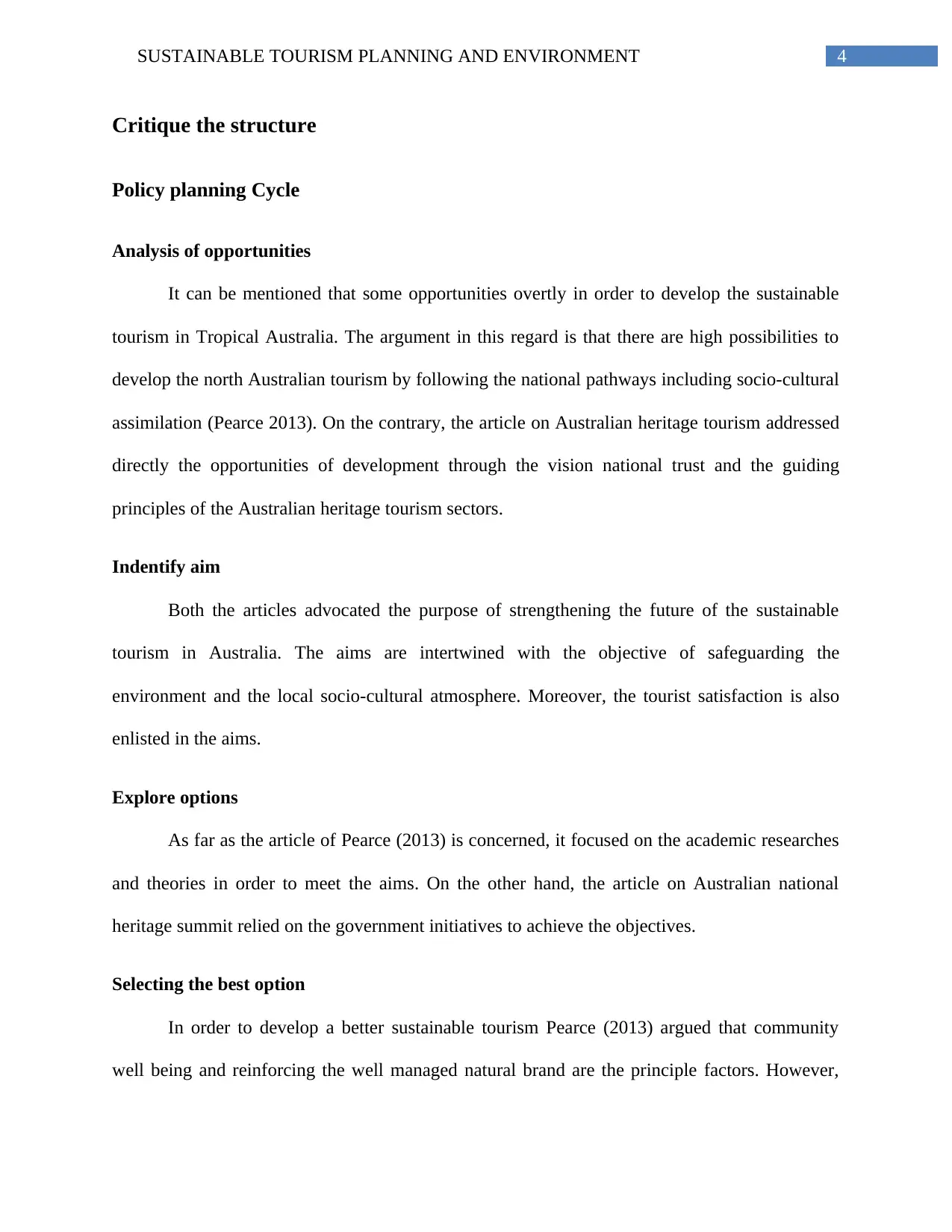
4SUSTAINABLE TOURISM PLANNING AND ENVIRONMENT
Critique the structure
Policy planning Cycle
Analysis of opportunities
It can be mentioned that some opportunities overtly in order to develop the sustainable
tourism in Tropical Australia. The argument in this regard is that there are high possibilities to
develop the north Australian tourism by following the national pathways including socio-cultural
assimilation (Pearce 2013). On the contrary, the article on Australian heritage tourism addressed
directly the opportunities of development through the vision national trust and the guiding
principles of the Australian heritage tourism sectors.
Indentify aim
Both the articles advocated the purpose of strengthening the future of the sustainable
tourism in Australia. The aims are intertwined with the objective of safeguarding the
environment and the local socio-cultural atmosphere. Moreover, the tourist satisfaction is also
enlisted in the aims.
Explore options
As far as the article of Pearce (2013) is concerned, it focused on the academic researches
and theories in order to meet the aims. On the other hand, the article on Australian national
heritage summit relied on the government initiatives to achieve the objectives.
Selecting the best option
In order to develop a better sustainable tourism Pearce (2013) argued that community
well being and reinforcing the well managed natural brand are the principle factors. However,
Critique the structure
Policy planning Cycle
Analysis of opportunities
It can be mentioned that some opportunities overtly in order to develop the sustainable
tourism in Tropical Australia. The argument in this regard is that there are high possibilities to
develop the north Australian tourism by following the national pathways including socio-cultural
assimilation (Pearce 2013). On the contrary, the article on Australian heritage tourism addressed
directly the opportunities of development through the vision national trust and the guiding
principles of the Australian heritage tourism sectors.
Indentify aim
Both the articles advocated the purpose of strengthening the future of the sustainable
tourism in Australia. The aims are intertwined with the objective of safeguarding the
environment and the local socio-cultural atmosphere. Moreover, the tourist satisfaction is also
enlisted in the aims.
Explore options
As far as the article of Pearce (2013) is concerned, it focused on the academic researches
and theories in order to meet the aims. On the other hand, the article on Australian national
heritage summit relied on the government initiatives to achieve the objectives.
Selecting the best option
In order to develop a better sustainable tourism Pearce (2013) argued that community
well being and reinforcing the well managed natural brand are the principle factors. However,
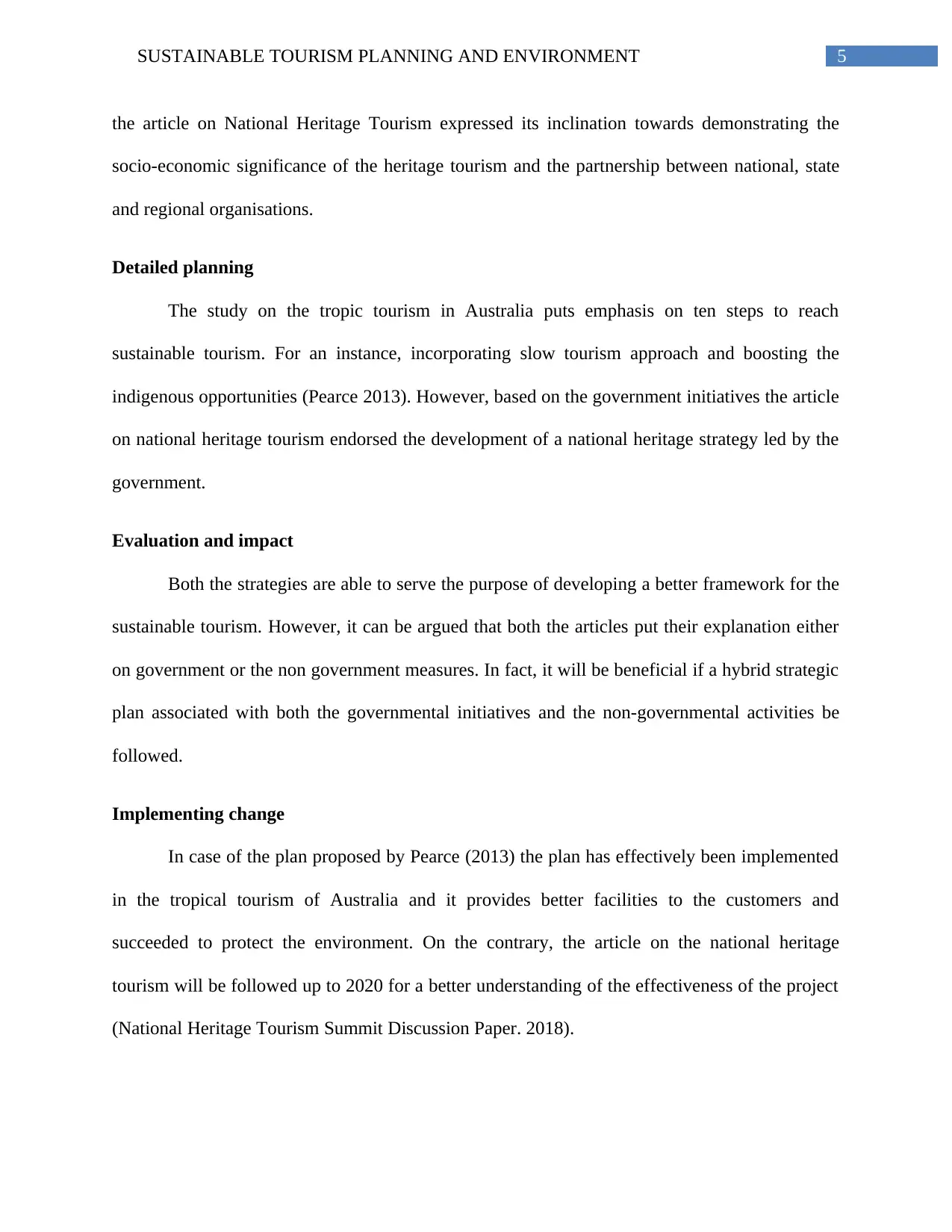
5SUSTAINABLE TOURISM PLANNING AND ENVIRONMENT
the article on National Heritage Tourism expressed its inclination towards demonstrating the
socio-economic significance of the heritage tourism and the partnership between national, state
and regional organisations.
Detailed planning
The study on the tropic tourism in Australia puts emphasis on ten steps to reach
sustainable tourism. For an instance, incorporating slow tourism approach and boosting the
indigenous opportunities (Pearce 2013). However, based on the government initiatives the article
on national heritage tourism endorsed the development of a national heritage strategy led by the
government.
Evaluation and impact
Both the strategies are able to serve the purpose of developing a better framework for the
sustainable tourism. However, it can be argued that both the articles put their explanation either
on government or the non government measures. In fact, it will be beneficial if a hybrid strategic
plan associated with both the governmental initiatives and the non-governmental activities be
followed.
Implementing change
In case of the plan proposed by Pearce (2013) the plan has effectively been implemented
in the tropical tourism of Australia and it provides better facilities to the customers and
succeeded to protect the environment. On the contrary, the article on the national heritage
tourism will be followed up to 2020 for a better understanding of the effectiveness of the project
(National Heritage Tourism Summit Discussion Paper. 2018).
the article on National Heritage Tourism expressed its inclination towards demonstrating the
socio-economic significance of the heritage tourism and the partnership between national, state
and regional organisations.
Detailed planning
The study on the tropic tourism in Australia puts emphasis on ten steps to reach
sustainable tourism. For an instance, incorporating slow tourism approach and boosting the
indigenous opportunities (Pearce 2013). However, based on the government initiatives the article
on national heritage tourism endorsed the development of a national heritage strategy led by the
government.
Evaluation and impact
Both the strategies are able to serve the purpose of developing a better framework for the
sustainable tourism. However, it can be argued that both the articles put their explanation either
on government or the non government measures. In fact, it will be beneficial if a hybrid strategic
plan associated with both the governmental initiatives and the non-governmental activities be
followed.
Implementing change
In case of the plan proposed by Pearce (2013) the plan has effectively been implemented
in the tropical tourism of Australia and it provides better facilities to the customers and
succeeded to protect the environment. On the contrary, the article on the national heritage
tourism will be followed up to 2020 for a better understanding of the effectiveness of the project
(National Heritage Tourism Summit Discussion Paper. 2018).
⊘ This is a preview!⊘
Do you want full access?
Subscribe today to unlock all pages.

Trusted by 1+ million students worldwide
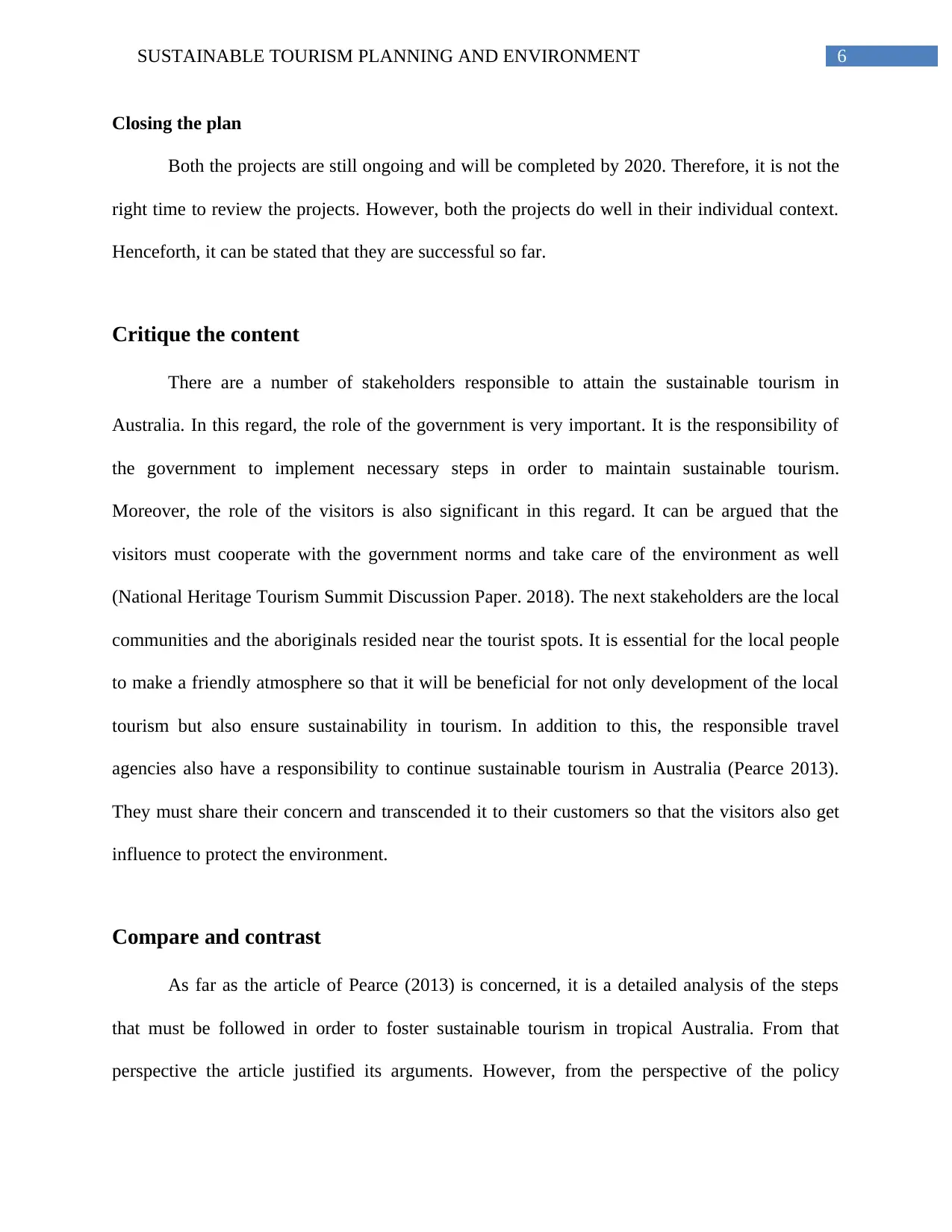
6SUSTAINABLE TOURISM PLANNING AND ENVIRONMENT
Closing the plan
Both the projects are still ongoing and will be completed by 2020. Therefore, it is not the
right time to review the projects. However, both the projects do well in their individual context.
Henceforth, it can be stated that they are successful so far.
Critique the content
There are a number of stakeholders responsible to attain the sustainable tourism in
Australia. In this regard, the role of the government is very important. It is the responsibility of
the government to implement necessary steps in order to maintain sustainable tourism.
Moreover, the role of the visitors is also significant in this regard. It can be argued that the
visitors must cooperate with the government norms and take care of the environment as well
(National Heritage Tourism Summit Discussion Paper. 2018). The next stakeholders are the local
communities and the aboriginals resided near the tourist spots. It is essential for the local people
to make a friendly atmosphere so that it will be beneficial for not only development of the local
tourism but also ensure sustainability in tourism. In addition to this, the responsible travel
agencies also have a responsibility to continue sustainable tourism in Australia (Pearce 2013).
They must share their concern and transcended it to their customers so that the visitors also get
influence to protect the environment.
Compare and contrast
As far as the article of Pearce (2013) is concerned, it is a detailed analysis of the steps
that must be followed in order to foster sustainable tourism in tropical Australia. From that
perspective the article justified its arguments. However, from the perspective of the policy
Closing the plan
Both the projects are still ongoing and will be completed by 2020. Therefore, it is not the
right time to review the projects. However, both the projects do well in their individual context.
Henceforth, it can be stated that they are successful so far.
Critique the content
There are a number of stakeholders responsible to attain the sustainable tourism in
Australia. In this regard, the role of the government is very important. It is the responsibility of
the government to implement necessary steps in order to maintain sustainable tourism.
Moreover, the role of the visitors is also significant in this regard. It can be argued that the
visitors must cooperate with the government norms and take care of the environment as well
(National Heritage Tourism Summit Discussion Paper. 2018). The next stakeholders are the local
communities and the aboriginals resided near the tourist spots. It is essential for the local people
to make a friendly atmosphere so that it will be beneficial for not only development of the local
tourism but also ensure sustainability in tourism. In addition to this, the responsible travel
agencies also have a responsibility to continue sustainable tourism in Australia (Pearce 2013).
They must share their concern and transcended it to their customers so that the visitors also get
influence to protect the environment.
Compare and contrast
As far as the article of Pearce (2013) is concerned, it is a detailed analysis of the steps
that must be followed in order to foster sustainable tourism in tropical Australia. From that
perspective the article justified its arguments. However, from the perspective of the policy
Paraphrase This Document
Need a fresh take? Get an instant paraphrase of this document with our AI Paraphraser
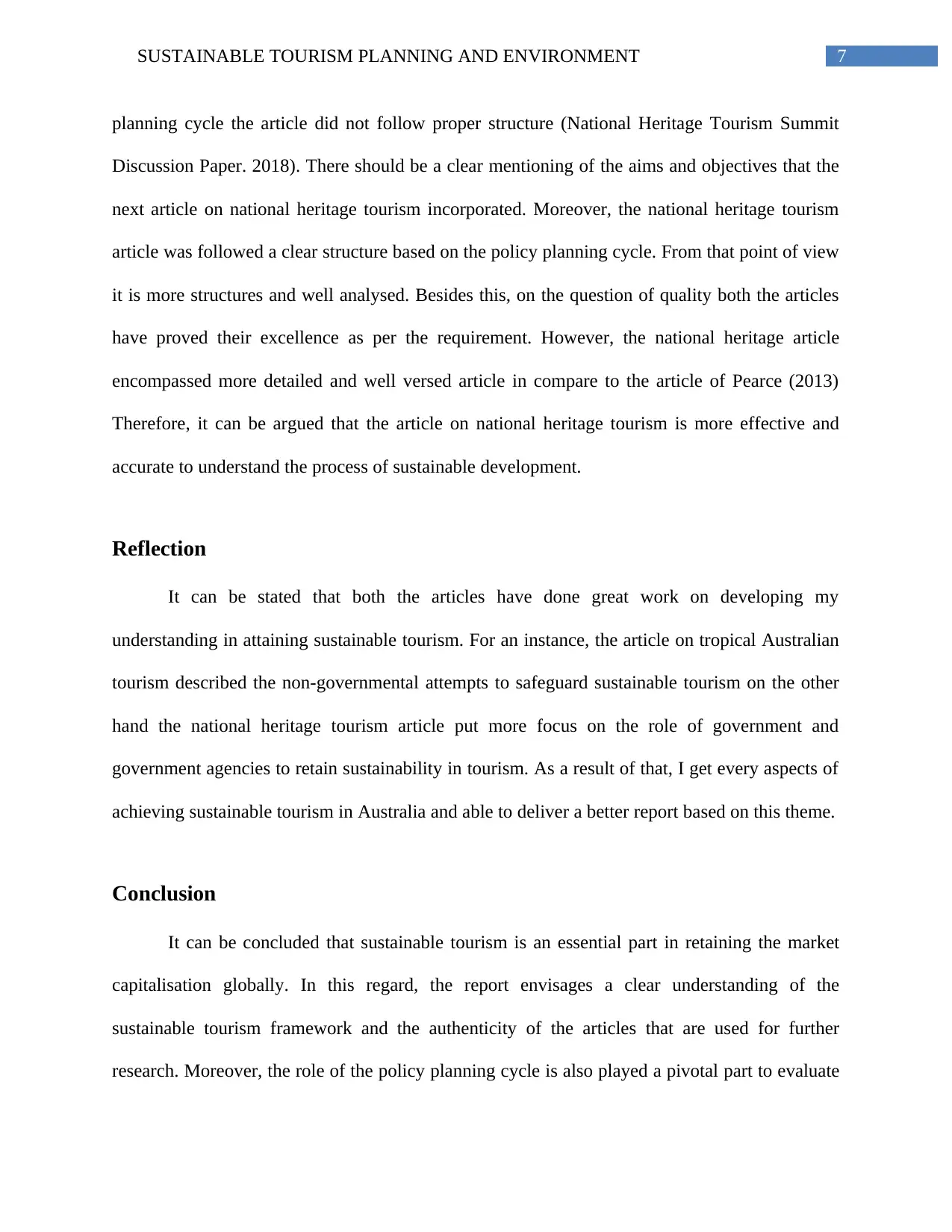
7SUSTAINABLE TOURISM PLANNING AND ENVIRONMENT
planning cycle the article did not follow proper structure (National Heritage Tourism Summit
Discussion Paper. 2018). There should be a clear mentioning of the aims and objectives that the
next article on national heritage tourism incorporated. Moreover, the national heritage tourism
article was followed a clear structure based on the policy planning cycle. From that point of view
it is more structures and well analysed. Besides this, on the question of quality both the articles
have proved their excellence as per the requirement. However, the national heritage article
encompassed more detailed and well versed article in compare to the article of Pearce (2013)
Therefore, it can be argued that the article on national heritage tourism is more effective and
accurate to understand the process of sustainable development.
Reflection
It can be stated that both the articles have done great work on developing my
understanding in attaining sustainable tourism. For an instance, the article on tropical Australian
tourism described the non-governmental attempts to safeguard sustainable tourism on the other
hand the national heritage tourism article put more focus on the role of government and
government agencies to retain sustainability in tourism. As a result of that, I get every aspects of
achieving sustainable tourism in Australia and able to deliver a better report based on this theme.
Conclusion
It can be concluded that sustainable tourism is an essential part in retaining the market
capitalisation globally. In this regard, the report envisages a clear understanding of the
sustainable tourism framework and the authenticity of the articles that are used for further
research. Moreover, the role of the policy planning cycle is also played a pivotal part to evaluate
planning cycle the article did not follow proper structure (National Heritage Tourism Summit
Discussion Paper. 2018). There should be a clear mentioning of the aims and objectives that the
next article on national heritage tourism incorporated. Moreover, the national heritage tourism
article was followed a clear structure based on the policy planning cycle. From that point of view
it is more structures and well analysed. Besides this, on the question of quality both the articles
have proved their excellence as per the requirement. However, the national heritage article
encompassed more detailed and well versed article in compare to the article of Pearce (2013)
Therefore, it can be argued that the article on national heritage tourism is more effective and
accurate to understand the process of sustainable development.
Reflection
It can be stated that both the articles have done great work on developing my
understanding in attaining sustainable tourism. For an instance, the article on tropical Australian
tourism described the non-governmental attempts to safeguard sustainable tourism on the other
hand the national heritage tourism article put more focus on the role of government and
government agencies to retain sustainability in tourism. As a result of that, I get every aspects of
achieving sustainable tourism in Australia and able to deliver a better report based on this theme.
Conclusion
It can be concluded that sustainable tourism is an essential part in retaining the market
capitalisation globally. In this regard, the report envisages a clear understanding of the
sustainable tourism framework and the authenticity of the articles that are used for further
research. Moreover, the role of the policy planning cycle is also played a pivotal part to evaluate
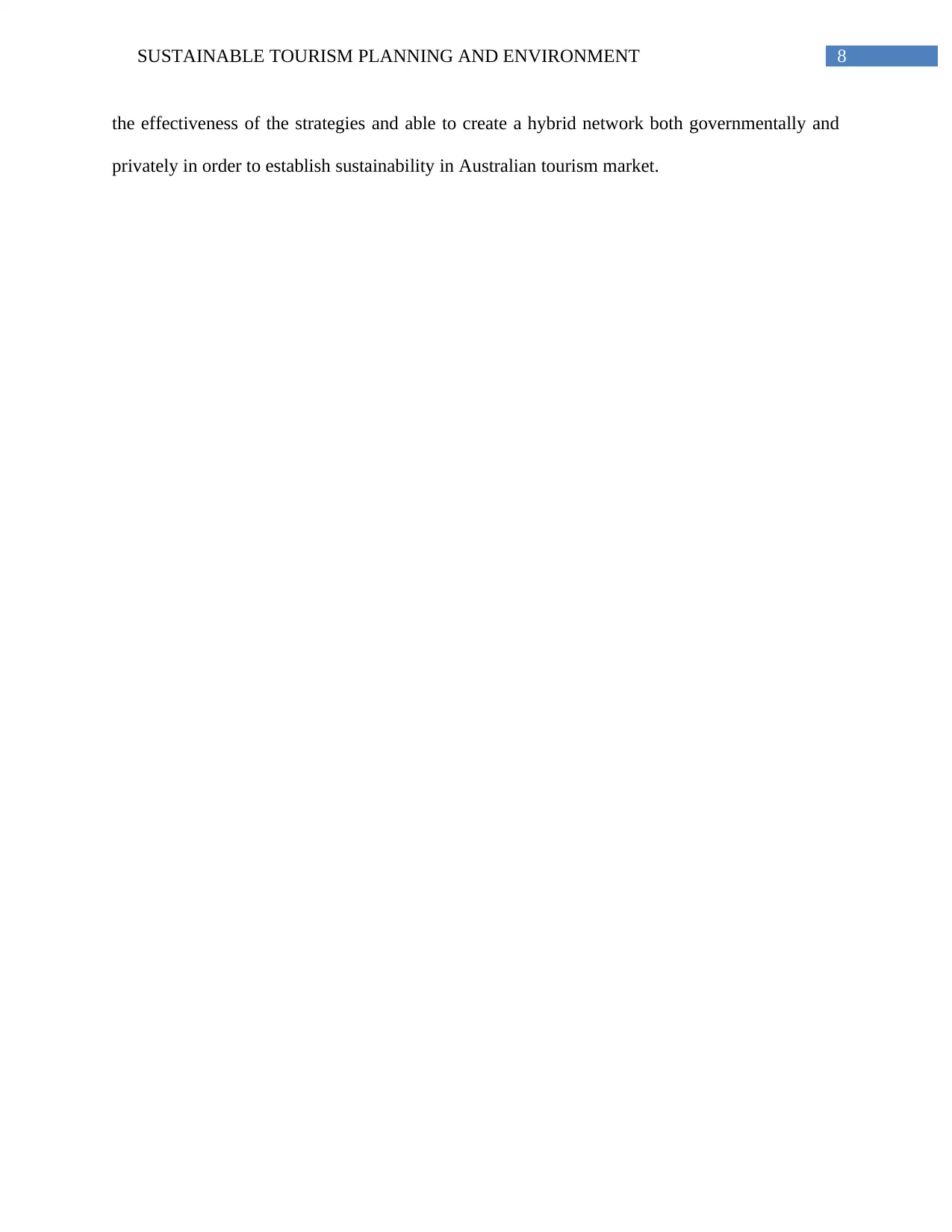
8SUSTAINABLE TOURISM PLANNING AND ENVIRONMENT
the effectiveness of the strategies and able to create a hybrid network both governmentally and
privately in order to establish sustainability in Australian tourism market.
the effectiveness of the strategies and able to create a hybrid network both governmentally and
privately in order to establish sustainability in Australian tourism market.
⊘ This is a preview!⊘
Do you want full access?
Subscribe today to unlock all pages.

Trusted by 1+ million students worldwide
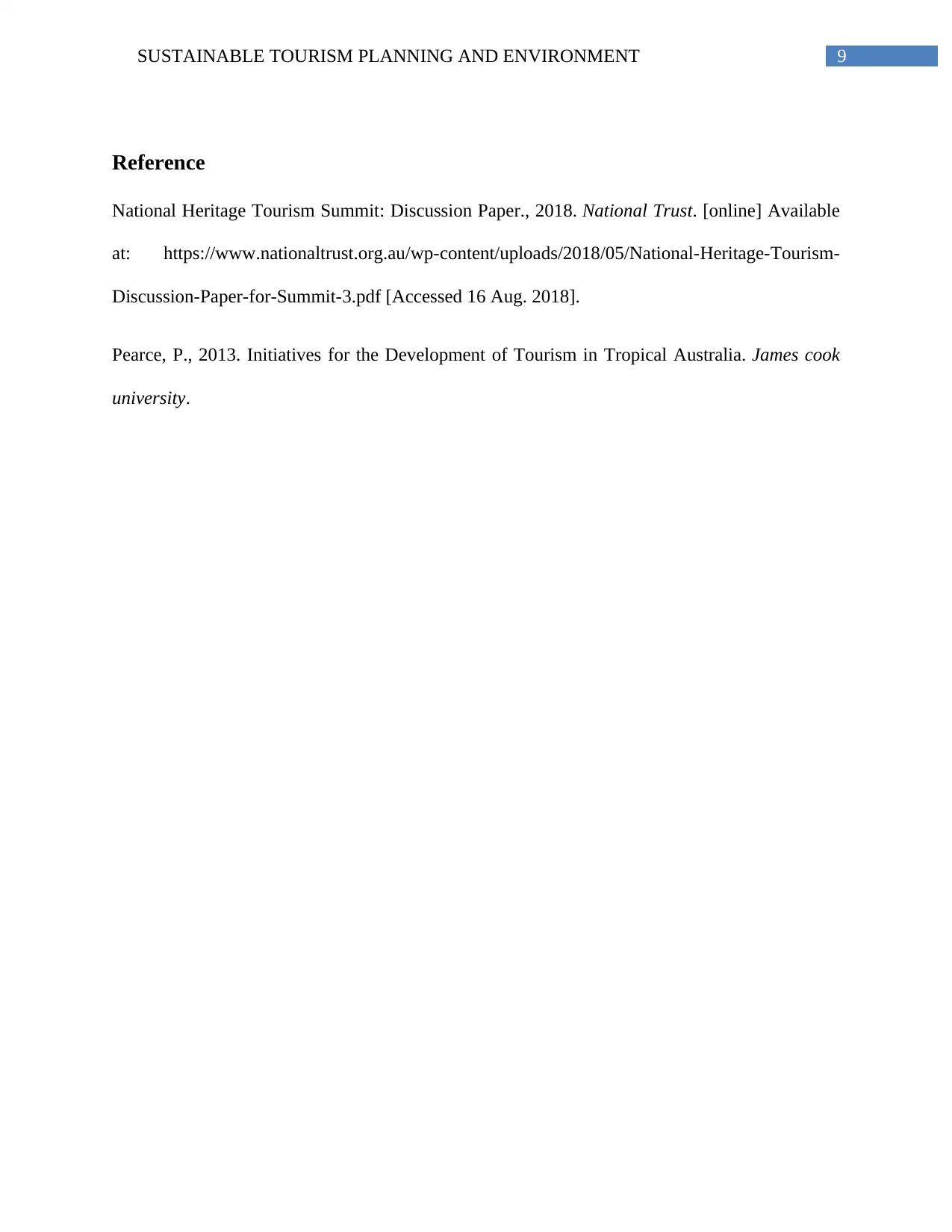
9SUSTAINABLE TOURISM PLANNING AND ENVIRONMENT
Reference
National Heritage Tourism Summit: Discussion Paper., 2018. National Trust. [online] Available
at: https://www.nationaltrust.org.au/wp-content/uploads/2018/05/National-Heritage-Tourism-
Discussion-Paper-for-Summit-3.pdf [Accessed 16 Aug. 2018].
Pearce, P., 2013. Initiatives for the Development of Tourism in Tropical Australia. James cook
university.
Reference
National Heritage Tourism Summit: Discussion Paper., 2018. National Trust. [online] Available
at: https://www.nationaltrust.org.au/wp-content/uploads/2018/05/National-Heritage-Tourism-
Discussion-Paper-for-Summit-3.pdf [Accessed 16 Aug. 2018].
Pearce, P., 2013. Initiatives for the Development of Tourism in Tropical Australia. James cook
university.
1 out of 10
Related Documents
Your All-in-One AI-Powered Toolkit for Academic Success.
+13062052269
info@desklib.com
Available 24*7 on WhatsApp / Email
![[object Object]](/_next/static/media/star-bottom.7253800d.svg)
Unlock your academic potential
Copyright © 2020–2025 A2Z Services. All Rights Reserved. Developed and managed by ZUCOL.



